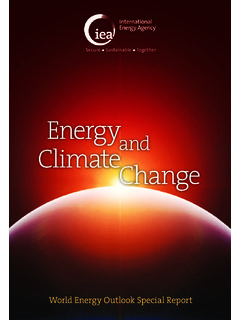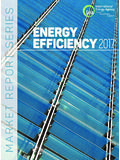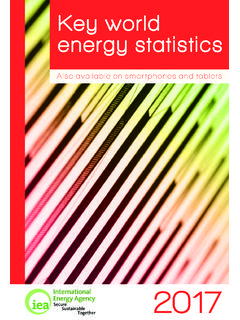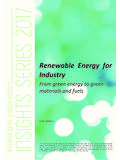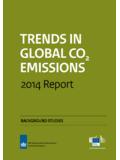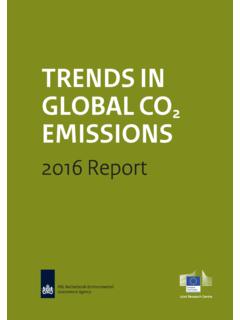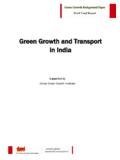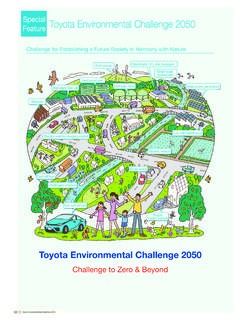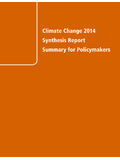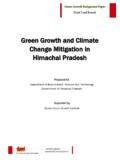Transcription of Global Energy & CO Status Report - iea.org
1 Global Energy & CO2 Status Report 2017. March 2018. OECD/IEA 2018. Global Energy and CO2 Status Report - 2017 Key findings Energy : Global Energy demand increased by in 2017, compared with the previous year and on average over the previous five years. More than 40% of the growth in 2017 was driven by China and India; 72% of the rise was met by fossil fuels, a quarter by renewables and the remainder by nuclear. Carbon dioxide (CO2): Global Energy -related co2 emissions grew by in 2017, reaching a historic high of gigatonnes (Gt), a resumption of growth after three years of Global emissions remaining flat. The increase in co2 emissions , however, was not universal. While most major economies saw a rise, some others experienced declines, including the United States, United Kingdom, Mexico and Japan. The biggest decline drop came from the United States, mainly because of higher deployment of renewables. Oil: World oil demand rose by (or million barrels a day) in 2017, a rate that was much higher than the annual average of 1% seen over the last decade.
2 An increasing share of sport-utility vehicles and light trucks in major economies and demand from the petrochemicals sector bolstered this growth. Natural gas: Global natural gas demand grew by 3%, thanks in large part to abundant and relatively low-cost supplies. China alone accounted for almost 30% of Global growth. In the past decade, half of Global gas demand growth came from the power sector; last year, however, over 80% of the rise came from industry and buildings. Coal: Global coal demand rose about 1% in 2017, reversing the declining trend seen over the last two years. This growth was mainly due to demand in Asia, almost entirely driven by an increase in coal- fired electricity generation. Renewables: Renewables saw the highest growth rate of any Energy source in 2017, meeting a quarter of Global Energy demand growth last year. China and the United States led this unprecedented growth, contributing around 50% of the increase in renewables-based electricity generation, followed by the European Union, India and Japan.
3 Wind power accounted for 36% of the growth in renewables- based power output. Electricity: World electricity demand increased by , significantly higher than the overall increase in Energy demand. Together, China and India accounted for 70% of this growth. Output from nuclear plants rose by 26 terawatt hours (TWh) in 2017, as a significant amount of new nuclear capacity saw its first full year of operation. Energy efficiency: Improvements in Global Energy efficiency slowed down dramatically in 2017, because of weaker improvement in efficiency policy coverage and stringency as well as lower Energy prices. Global Energy intensity improved by only in 2017, compared with an average of over the last three years. OECD/IEA 2018 1 Global Energy and CO2 Status Report - 2017 Overview: Global Energy demand 2017. Global Energy demand grew by in 2017, according to IEA preliminary estimates, more than twice the growth rate in 2016.
4 Global Energy demand in 2017 reached an estimated 14 050 million tonnes of oil equivalent (Mtoe), compared with 10 035 Mtoe in 2000. Fossil-fuels met 70% of the growth in Energy demand around the world. Natural gas demand increased the most, reaching a record share of 22% in total Energy demand. Renewables also grew strongly, making up around a quarter of Global Energy demand growth, while nuclear use accounted for 2% of the growth. The overall share of fossil fuels in Global Energy demand in 2017 remained at 81%, a level that has remained stable for more than three decades despite strong growth in renewables. Improvements in Global Energy efficiency slowed down. The rate of decline in Global Energy intensity, defined 1. as the Energy consumed per unit of economic output, slowed to only in 2017, much lower than the improvement seen in 2016. The growth in Global Energy demand was concentrated in Asia, with China and India together representing more than 40% of the increase.
5 Energy demand in all advanced economies contributed more than 20% of Global Energy demand growth, although their share in total Energy use continued to fall. Notable growth was also registered in Southeast Asia (which accounted for 8% of Global Energy demand growth) and Africa (6%), although per capita Energy use in these regions still remains well below the Global average. Average annual growth in Energy demand by fuel 300 3% Renewables Mtoe Nuclear 200 2%. Gas Oil 100 1%. Coal Net growth rate 0 0%. (right axis). - 100 -1%. 2006-2015 2016 2017. OECD/IEA 2018 1. Corrected 23 March 2018 from to 2 Global Energy and CO2 Status Report - 2017 co2 emissions Global Energy -related co2 emissions rose by in 2017, an increase of 460 million tonnes (Mt), and reached a historic high of Gt. Last year's growth came after three years of flat emissions and contrasts with the sharp reduction needed to meet the goals of the Paris Agreement on climate change.
6 The increase in carbon emissions , equivalent to the emissions of 170 million additional cars, was the result of robust Global economic growth of , lower fossil-fuel prices and weaker Energy efficiency efforts. These three factors contributed to pushing up Global Energy demand by in 2017. The trend of growing emissions , however, was not universal. While most major economies saw a rise in carbon emissions , some others experienced declines, such as the United States, the United Kingdom, Mexico and Japan. The biggest decline came from the United States, where emissions dropped by , or 25 Mt, to 4 810 Mt of CO2, marking the third consecutive year of decline. While coal-to-gas switching played a major role in reducing emissions in previous years, last year the drop was the result of higher renewables-based electricity generation and a decline in electricity demand. The share of renewables in electricity generation reached a record level of 17%, while the share of nuclear power held steady at 20%.
7 Global Energy -related co2 emissions , 2000-2017 35. Gt CO2. 30. co2 emissions 25 Increase 2016-17. 20. 15. 10. 5. In the United Kingdom, emissions dropped by , or 15 Mt, to 350 Mt of CO2, their lowest level on record back to 1960. A continued shift away from coal towards gas and renewables led to a 19% drop in coal demand. In Mexico, emissions dropped by 4%, driven by a decline in oil and coal use, efficiency gains in the power system, strong growth in renewables-based electricity generation and a slight increase in overall gas use. In Japan, emissions fell by as increased electricity generation from renewables and nuclear generation displaced generation from fossil-fuels, especially oil. Overall, Asian economies accounted for two-thirds of the Global increase in carbon emissions . China's economy grew nearly 7% last year but emissions increased by just (or 150 Mt) thanks to continued renewables deployment and faster coal-to-gas switching.
8 China's co2 emissions in 2017 reached Gt, almost 1% higher than their 2014 level. While China's coal demand peaked in 2013, Energy -related emissions have nonetheless increased because of rising oil and gas demand. OECD/IEA 2018 3 Global Energy and CO2 Status Report - 2017 Global GDP, Energy demand and Energy -related carbon dioxide emissions , 2000-2017 In India, economic growth bolstered rising Energy demand and continued to drive up emissions , but at half the rate seen during the past decade. India's per-capita emissions last year were tCO2, well below the Global per capita average of tCO2. emissions in the European Union grew by , adding almost 50 MtCO2, reversing some of the progress made in recent years mainly due to robust growth in oil and gas use. The rate of Energy intensity improvement slowed to , down from the previous year. Southeast Asian economies also contributed to the rise in emissions , with Indonesia leading the growth with an increase of relative to 2016.
9 The growth in Energy -related carbon dioxide emissions in 2017 is a strong warning for Global efforts to combat climate change, and demonstrates that current efforts are insufficient to meet the objectives of the Paris Agreement. Change in Energy -related carbon dioxide emissions by selected region, 2017 The IEA's Sustainable Development Scenario charts a path towards meeting long-term climate goals. Under this scenario, Global emissions need to peak soon and decline steeply to 2020; this decline will now need to be even greater given the increase in emissions in 2017. The share of low-carbon Energy sources must increase by percentage points every year, more than five-times the growth registered in 2017. In the power sector, specifically, generation from renewable sources must increase by an average 700 TWh annually in that scenario, an 80% increase compared to the 380 TWh increase registered in 2017. Carbon Capture, Usage and Storage (CCUS) plays an important role for reducing emissions in the industry and power sectors.
10 OECD/IEA 2018 4 Global Energy and CO2 Status Report - 2017 Oil Global oil demand rose by million barrels a day (mb/d) in 2017, continuing a trend of strong growth since prices fell in 2014. The rate of growth of was much higher than the average annual growth rate of 1% seen over the past decade. One of the main drivers of growth was the transport sector. Vehicle ownership levels increased in 2017, as did the share of Sport Utility Vehicles (SUVs) and other large vehicles. This was particularly visible in the United States, where the share of SUVs and light trucks increased from 47% in 2011 to around 60% of total sales in 2017, bringing up the share of these vehicles in the total passenger car fleet to almost half. It is also a factor in the European Union, where oil demand increased by 2%, the highest rate of growth since 2001. Average annual growth in oil demand mb/d Oil Net growth rate (right axis). 1985-2005 2006-2015 2016 2017.
